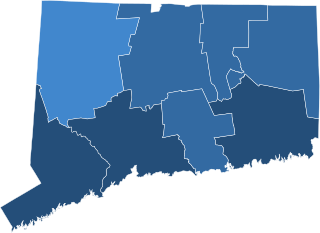
The 1816 United States presidential election was the eighth quadrennial presidential election. It was held from Friday, November 1 to Wednesday, December 4, 1816. In the first election following the end of the War of 1812, Democratic-Republican candidate James Monroe defeated Federalist Rufus King. The election was the last in which the Federalist Party fielded a presidential candidate.

Since Connecticut became a U.S. state in 1788, it has sent congressional delegations to the United States Senate and United States House of Representatives, beginning with the 1st United States Congress in 1789. Each state elects two senators to serve for six years in general elections, with their re-election staggered. Prior to the ratification of the Seventeenth Amendment in 1913, senators were elected by the Connecticut General Assembly. Each state elects varying numbers of members of the House, depending on population, to two-year terms. Connecticut has sent five members to the House in each congressional delegation since the 2000 United States Census.

Alexander Wolcott was a United States politician, customs inspector, and nominee to the Supreme Court of the United States. Nominated by James Madison in 1811, to replace the late William Cushing, he was rejected by the United States Senate by a vote of 9–24. He was later a delegate to the 1818 convention that drafted the Constitution of Connecticut.

Oliver Wolcott Jr. was an American politician and judge. He was the second United States Secretary of the Treasury, a judge of the United States Circuit Court for the Second Circuit, and the 24th Governor of Connecticut. His adult life began with working in Connecticut, followed by participating in the U.S. federal government in the Department of Treasury, before returning to Connecticut, where he spent his life before his death. Throughout his time in politics, Wolcott's political views shifted from Federalist, to Toleration, and finally Jacksonian. Oliver Wolcott Jr. is the son to Oliver Wolcott Sr., part of the Griswold-Wolcott family.
The Toleration Party, also known as the Toleration-Republican Party and later the American Party or American Toleration and Reform Party, was a political party that dominated the political life of Connecticut from 1817 to 1827. The American name referred not to nativism or the later Know Nothing, which was also known as the American Party, but to the party's national orientation. The party was formed by an alliance of the more conservative Episcopalians with the Democratic-Republicans, as a result of the discrimination of the Episcopal Church by the Congregationalist state government. In the 1817 elections, the Toleration Party swept control of the General Assembly. At the Connecticut Constitutional Convention in 1817, 111 of the 201 convention delegates belonged to the Toleration Party. The resulting Constitution of 1818 generally adhered to the Tolerationist platform, especially their two major issues: increasing the electorate and the democratic nature of the government and disestablishing the Congregational Church. By the end of the 1820s, the Tolerationists had developed into the Jacksonian branch of the Connecticut Democratic Party.

The 1827 Connecticut gubernatorial election was held on April 12, 1827. Former congressman, speaker and Democratic-Republican candidate Gideon Tomlinson defeated incumbent governor and Democratic-Republican candidate Oliver Wolcott Jr., winning with 56.71% of the vote.

The 1826 Connecticut gubernatorial election was held on April 13, 1826. Incumbent governor and Toleration Party candidate Oliver Wolcott Jr. defeated former senator and Federalist Party candidate David Daggett, winning with 56.77% of the vote.

The 1825 Connecticut gubernatorial election was held on April 14, 1825. Incumbent governor and Toleration Party candidate Oliver Wolcott Jr. defeated Federalist Party candidates former senator David Daggett, former delegate Nathan Smith and former congressman Timothy Pitkin, winning with 68.82% of the vote.

The 1823 Connecticut gubernatorial election was held on April 10, 1823. Incumbent governor and Toleration Party candidate Oliver Wolcott Jr. won re-election with 88.96% of the vote.

The 1821 Connecticut gubernatorial election was held on April 12, 1821. Incumbent governor and Toleration Party candidate Oliver Wolcott Jr. was re-elected, winning with 86.91% of the vote.

The 1820 Connecticut gubernatorial election was held on April 13, 1820. Incumbent governor and Democratic-Republican Party candidate Oliver Wolcott Jr. was re-elected, defeating Federalist Party candidates former delegate Nathan Smith and former congressman and state legislator Timothy Pitkin with 76.14% of the vote.

The 1819 Connecticut gubernatorial election was held on April 8, 1819. Incumbent governor and Democratic-Republican Party candidate Oliver Wolcott Jr. was re-elected, winning with 86.85% of the vote.

The 1813 Connecticut gubernatorial election took place on April 12, 1813.

The 1815 Connecticut gubernatorial election took place on April 10, 1815.

The 1809 Connecticut gubernatorial election took place on April 10, 1809.

The 1810 Connecticut gubernatorial election took place on April 9, 1810.

The 1814 Connecticut gubernatorial election took place on April 11, 1814.

The 1816 Connecticut gubernatorial election was held on 11 April 1816 in order to elect the Governor of Connecticut. Incumbent Federalist Governor of Connecticut John Cotton Smith won re-election against Democratic-Republican nominee and former United States Secretary of the Treasury Oliver Wolcott Jr..

The 1797 Connecticut gubernatorial election was held on 13 April 1797 in order to elect the Governor of Connecticut. Incumbent Federalist Governor of Connecticut Oliver Wolcott won re-election as he ran unopposed.


















